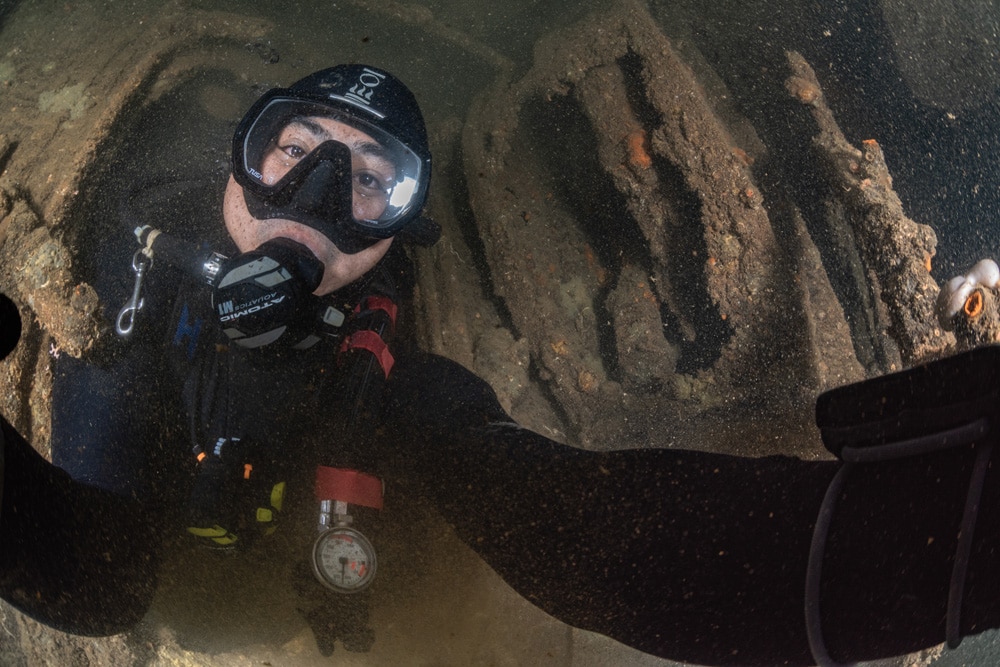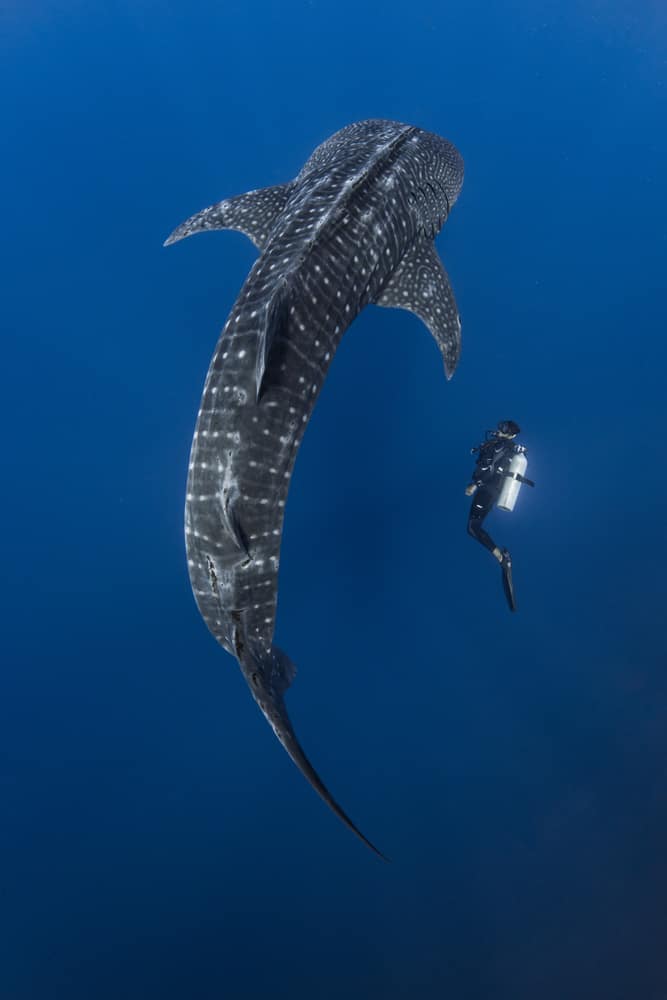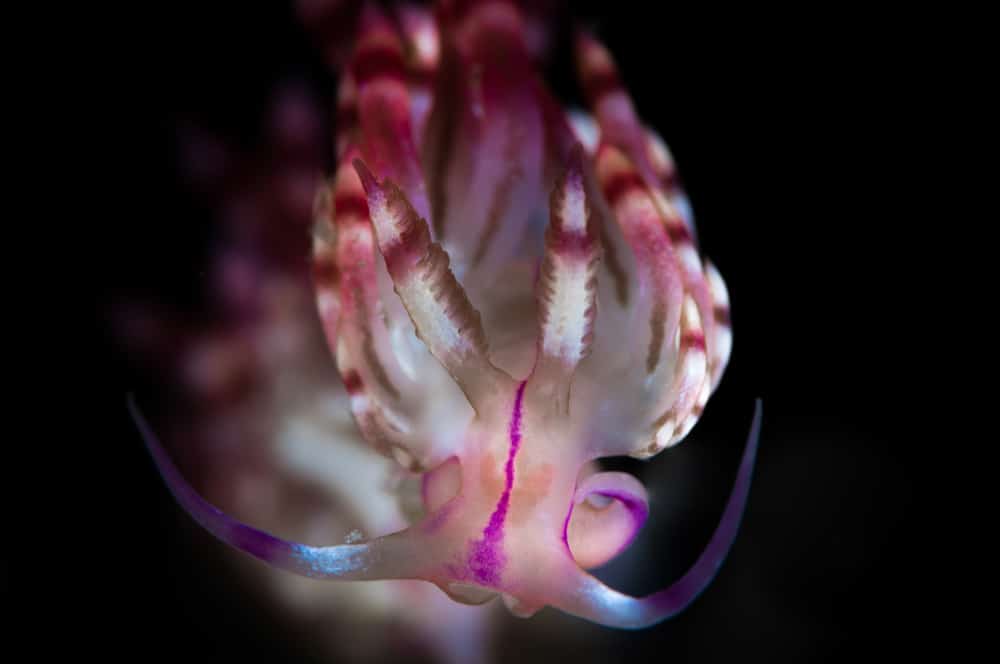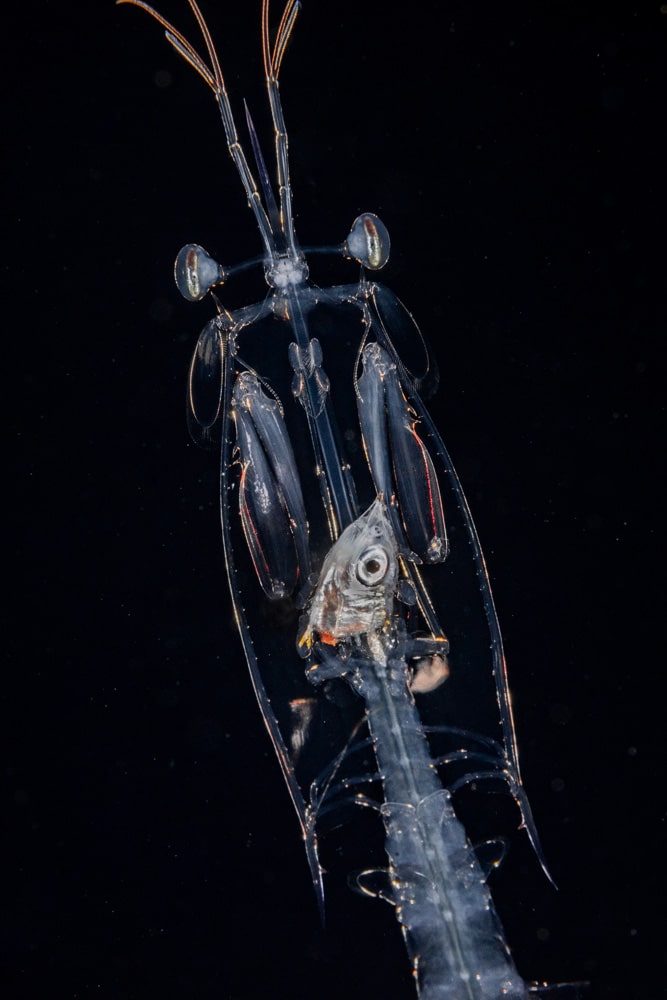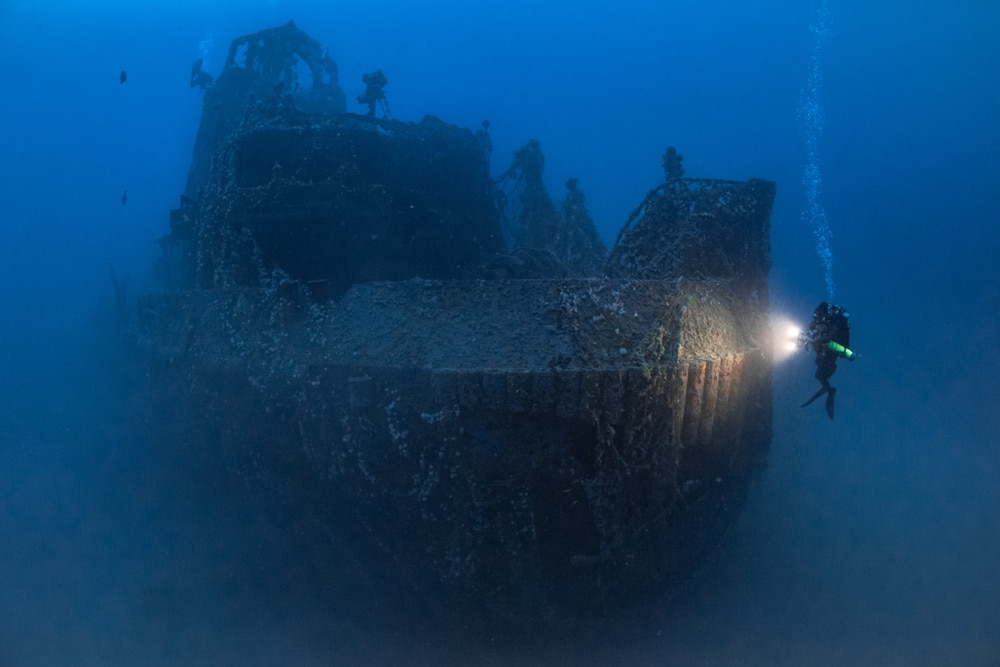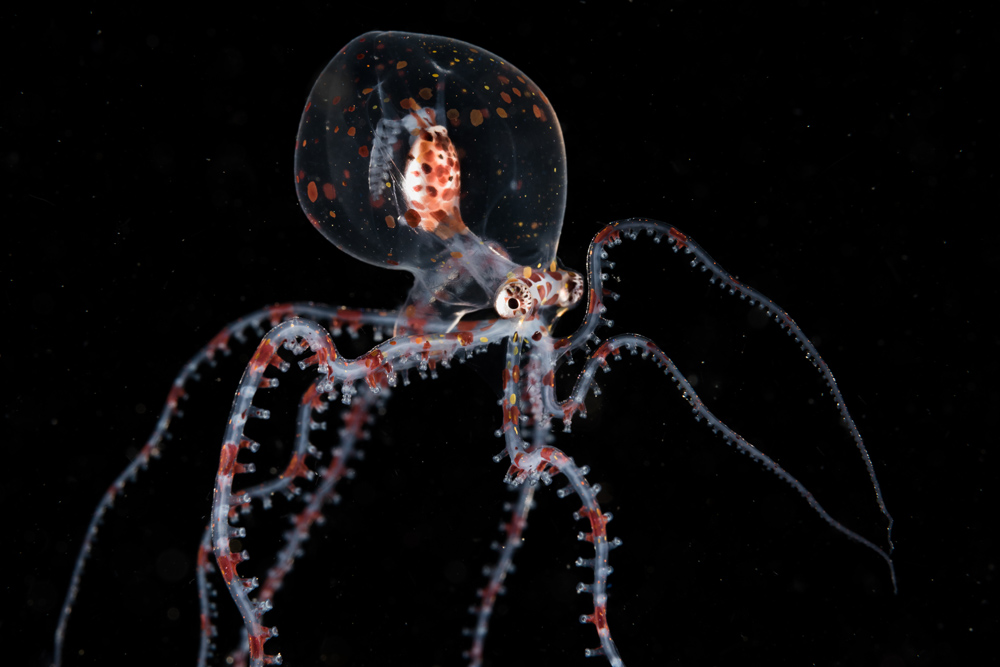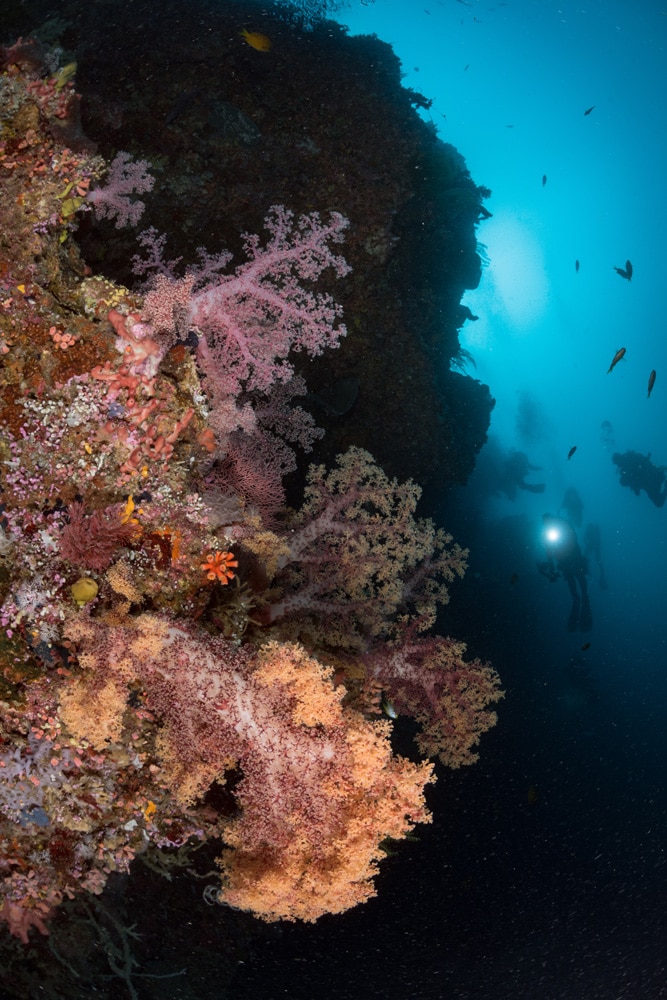Photo / Video News & Reviews
Scubaverse Underwater Photographer Interview: Ram Yoro
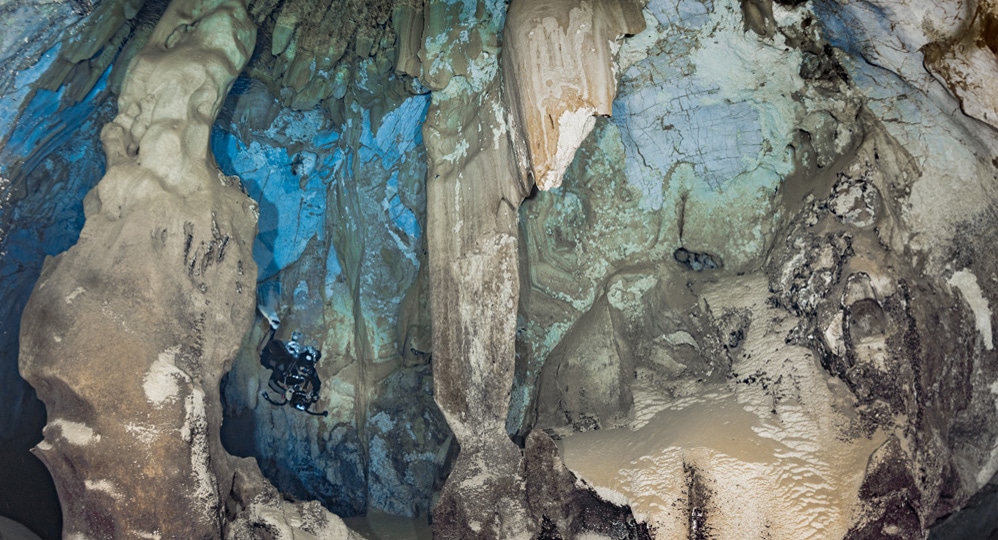
In this ongoing series, Scubaverse’s Underwater Photography Editor Nick Robertson-Brown talks to underwater photographers from around the world that he admires. In this blog: Ram Yoro
Ram lives in archipelagic Philippines where frequent excursions to nearby reefs in his early years triggered a life-long passion for exploring the oceans. His deep curiosity and love for the underwater world eventually made him leave a young corporate career to become a full-time scuba instructor and underwater photographer. For more than a decade since, Ram has actively conducted scuba lessons and underwater photography workshops in his base in Anilao.
As an underwater photographer, he is a pioneer and proponent of the Bonfire Diving method for documenting plankton in coastal waters. His appetite for exploration also led him into the realm of technical diving, and to specialize in underwater cave and wreck photography as member of the Filipino Cave Divers organization.
Aside from winning multiple awards over the years in the Anilao Shootout, a prestigious international live underwater photo competition, Ram also co-authored two books – the “Guide to Anilao” and “Legends Beneath the Waves: Philippines”. Moreover, he is also a major contributor to the following recent publications – “Black is the New Blue Volume II”, “Philippine Caves”, and “Philippine Coral Reefs”. When not in exploration mode, Ram spends his time with his little mermaids Yana and Mara, and wife Geraldine who is also a scuba diver.
NRB: How did your underwater photography start?
RY: I consider myself blessed to have witnessed and enjoyed the beauty of the reefs at a young age and always had this craving to share it with others. I thought the best way to do this is by taking photos underwater so I invested in a compact underwater setup as soon as I could afford one. Initially it was just to satisfy my impulse to share what I love to others, and later on it evolved into artistic pursuit. To this day, and many camera systems later on, the ocean still never fails to amaze me and I always find it full of awe-inspiring stories to tell. It is humbling to know that as an underwater photographer, I get to be an ambassador of the oceans – I get to sit in front of its daily spectacle and tell others about it.
NRB: What is your favourite u/w camera equipment (past & present) & why?
RY: I started underwater photography in the dawn of the digital age when camera system options were limited and less affordable. I initially had to make do with what I could just afford and went through a trial and error process with early Canon S- and G-series compact systems over the years. As anyone who has tried them would attest however, the main frustration with compact cameras is their slow auto-focus speed especially in low-light environments like underwater. In this department however, back then, I was pleasantly surprised at how the Canon G16 performed – it became my go-to camera for some time, enabling me to capture many fleeting and split-second macro moments which are not uncommon in the reefs. Nowadays, technology has improved and many compact camera options enviably have auto-focus speeds that satisfy the demands of the dim and ever-dynamic marine environment.
I had no plans, or no means rather, to upgrade to a DSLR system until my supportive wife surprised me with a Nikon D810 as a birthday present. The D810 was a beast – on top of a bigger sensor that delivers top image quality and superb low-light performance, it had excellent auto-focus performance and a deep dynamic range that allowed me to capture unique macro moments and emphasize depth in wide angle shots. With the various lens options available to DSLR systems also, I was encouraged to push my D810 into the exciting worlds of blackwater and bonfire diving, as well as underwater cave and wreck photography. Though it may not be top-of-line anymore today, I still treasure and hold dear my old and trusty Nikon D810 for the many adventures we’ve been through.
NRB: What would be your advice to anyone new to underwater photography?
RY: After all these years and having gone through several underwater camera systems, I realize I keep coming back to my underwater photography basics. I would thus share with them the same advice I would give my younger self in hindsight, as cliché as it may sound – build good fundamentals, then constantly practice and dare to evolve.
Your fundamentals – understanding of the exposure triangle and lighting principles, among other things – will enable you to work with any camera system or in any environment. It will make you less reliant on equipment but rather go with your knowledge and skills more, which is very liberating nowadays given how fast equipment upgrades come by.
Constant practice on the other hand is key to skill mastery. Practice makes perfect as they say, and skill-heavy underwater photography is no exception – no shortcuts here, but don’t worry this is the fun part! Mastery is only gained when muscle memory and instincts are developed through repetition over time.
And finally, dare to evolve – try new things and keep yourself up to date with the latest methods, styles and tricks. This will push your creativity and keep you engaged in underwater photography, and I believe is the secret to your longevity in the craft. Moreover, it will also expand and keep your portfolio always fresh and relevant to the times.
NRB: What, or who, has been your single biggest inspiration for your underwater photography?
RY: Like many in my generation of local underwater photographers in the Philippines, I have always had great admiration for the many works of Palme D’or awardee Scott “Gutsy” Tuason. It is ironic that while we Filipinos are blessed with countless of vibrant reefs, many of us take it for granted because most of us – in the past at least – have not seen nor enjoyed the fullness of its diverse beauty.
Gutsy was a pioneer in the Philippines in the sense that he was the first to visually document and share the many unseen treasures in our seas. The effect of his stunning images on me and many in my generation was profound, and it made me realize that photography can be a great tool for spreading awareness about our oceans and inspiring people to care for it. His works did not only encourage me to get into underwater photography, but also gave my craft a sense of purpose. Without Gutsy’s influence, I probably would not be as engaged in underwater photography as I am today, and the endeavour certainly would not have been as meaningful.
NRB: What image are you most proud of and why?
RY: It’s challenging to pick a photo given that the objectivity of a photographer is often clouded by the efforts invested in getting the shot. There is however a recent photo, taken in June 2019, that I couldn’t be more pleased with. It’s a photo of a wreck in the Brunei high seas, the Petani Mistral, which was later presented to Sultan Hassanal Bolkiah Himself! It’s a rare and great honor for any photographer’s work to be appreciated by His Majesty, and my gratitude to Poni Divers for making it possible. The image was to be part of a book project with Poni Divers about the amazing wrecks of Brunei – originally set to be released late 2020, but postponed to a future date when the ongoing pandemic eases.
NRB: Where is your favourite dive location, and is it for the photography?
RY: Because of its diversity, you can never have too much of Anilao and for that reason I decided to make it my diving base about a decade ago. For underwater photography, it is widely popular for macro but if you look beyond you will find that it actually has the complete package. It also has abundant wide angle opportunities, superb bonfire and blackwater diving, and even an underwater cave system as well as a small but entertaining wreck to enjoy. Logistically, its geographically sheltered location makes Anilao diveable all year round, and being only 3 hours away from Metro Manila makes it conveniently accessible. For non-photographers of any level, it is just as enjoyable with a variety of marine life covered reefs to choose from – walls, drop offs, slopes, submerged mounds, and small atolls perfect for long lazy dives. A favorite of many divers, including myself, once you’ve been to Anilao it’s hard to lose that itch to keep coming back.
NRB: What are you views on marine life manipulation, moving subjects?
RY: Marine life manipulation is a sad aspect of underwater photography and it has to stop. In many cases it is a reflection of skewed priorities, where the photograph comes above anything else. We forget that the underwater world is a unique place with its own dynamics, and our mindless intervention to setup the perfect shot may make a subject vulnerable to premature predation or cause it direct physical harm. This unchecked mind-set has become rampant, even systemic in some areas already, but it is never too late to change our ways.
Like many anthropogenic issues, stubborn ignorance is partly to blame and therefore education is the remedy. We need to take responsibility, create awareness and educate ourselves to effect a positive culture change. As an industry, we need to remind ourselves of the obvious, that the underwater world is a delicate living ecosystem and we – as capable beings and its beneficiaries – have the duty to care for it as stewards. We need to institutionally spread this mind-set through scuba courses, photo workshops, and dive briefings. And on a personal level, we can push for this in social media posts, in casual chit chats, and in our own little ways. This collective effort may take a while but will hopefully plant the seeds for a lasting and omnipresent culture of caring and stewardship for the oceans in our small but growing industry.
NRB: What do you look for when you are making your images?
RY: We always hope to encounter crazy behaviour, amazing portraits, or magnificent scenes, but in fact most of the time we are presented with the common and the ordinary. I have learned to temper expectations and make the most of what is given, and realized it is just as fulfilling to make the ordinary look extraordinary through photography. As every photo is a story, I try to find the hidden narrative or make one, and then proceed to make the framing, settings, and lighting artistically emphasize it.
NRB: What motivates you to take u/w photos?
RY: In as much as I enjoy the process of underwater photography itself, I find it very fulfilling to bring stunning images of the ocean closer to people. I think it is probably innate in all of us to want to share and preserve what is beautiful, and I’m very lucky to be able to use my underwater photography for the same purpose for the oceans. I am even more driven nowadays, as the oceans that we enjoy and depend on are threatened by a host of anthropogenic and other harmful factors. It is amazing how visual art can create awareness and inspire people to act.
NRB: If you could photograph any one thing/place what or where would that be?
RY: I have always been fascinated by the deep sea angler fish. A distant relative of the frogfish, they exist in very deep and dark waters, armed with sharp teeth and a bio-luminescent lure. Their appearance invokes a mixture of awe, fear, and science-fiction. It’s mind-boggling that such creatures even exist. But they do, and they remind us that there is so much life yet to been seen in the oceans and, as we’ve been told, we have only scratched the surface to date.
It is unlikely that an adult deep sea angler fish may be seen within the diving depths but larval and juvenile versions have been reportedly caught in plankton nets in the shallow depth ranges. I think an encounter with a young deep sea angler fish vertically migrating to the shallows at night to feed on plankton is just a matter of time. I am hoping I’d be at the right time and place during a bonfire or blackwater dive in plankton rich Balayan Bay in Anilao one of these days.
To see more of Ram’s work visit his Instagram page.
To read Ram’s features in Philippines Dive Adventures click here.
Blogs
Diver Discovering Whale Skeletons Beneath Ice Judged World’s Best Underwater Photograph
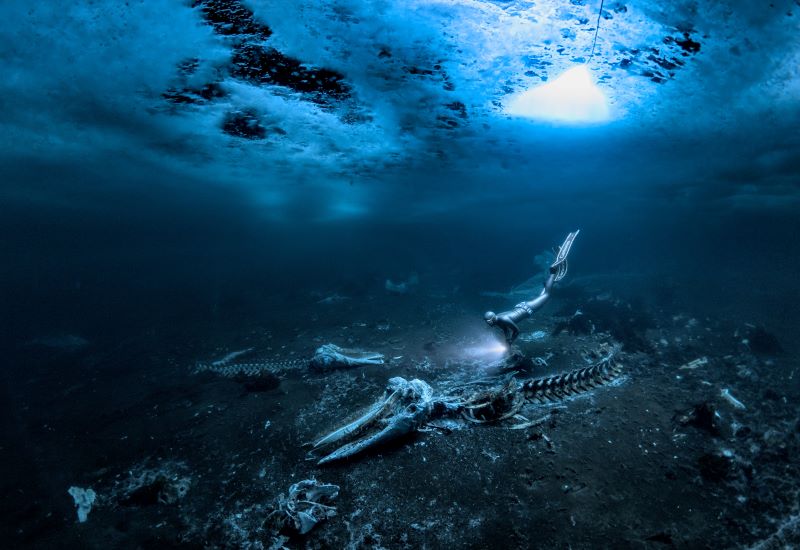
An emotive photograph showing a freediver examining the aftermath of whaling sees
Alex Dawson from Sweden named Underwater Photographer of the Year 2024. Dawson’s
photograph ‘Whale Bones’ triumphed over 6500 underwater pictures entered by underwater
photographers from around the world.
“Whale Bones was photographed in the toughest conditions,” explains chair of judging
panel Alex Mustard, “as a breath-hold diver descends below the Greenland ice sheet to bear
witness to the carcasses. The composition invites us to consider our impact on the great
creatures of this planet. Since the rise of humans, wild animals have declined by 85%. Today,
just 4% of mammals are wildlife, the remaining 96% are humans and our livestock. Our way
needs to change to find a balance with nature.”
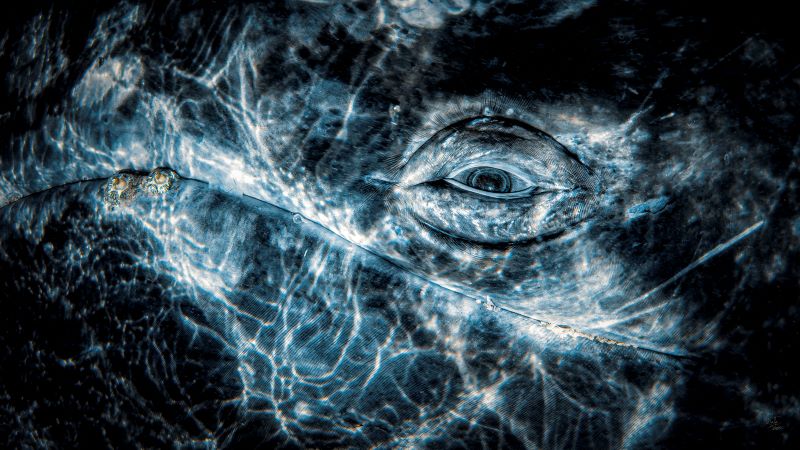
Photo: Rafael
Fernandez Caballero
Whales dominated the winning pictures this year with Spanish photographer Rafael
Fernandez Caballero winning two categories with his revealing photos of these ocean giants:
a close up of a grey whale’s eye and an action shot of a Bryde’s whale engulfing an entire bait
ball, both taken in Magdalena Bay, Baja California, Mexico. Fernandez Caballero took ‘Grey
Whale Connection’ while drifting in a small boat, holding his camera over the side in the water
to photograph the curious whale. ‘The End Of A Baitball’ required Fernandez Caballero to dive
down and be in exactly the right place at the moment the whale lunged. “The photo shows
the high speed attack,” he said, “with the whale engulfing hundreds of kilograms of sardines
in one bite — simply unforgettable to see predation on such a scale.”
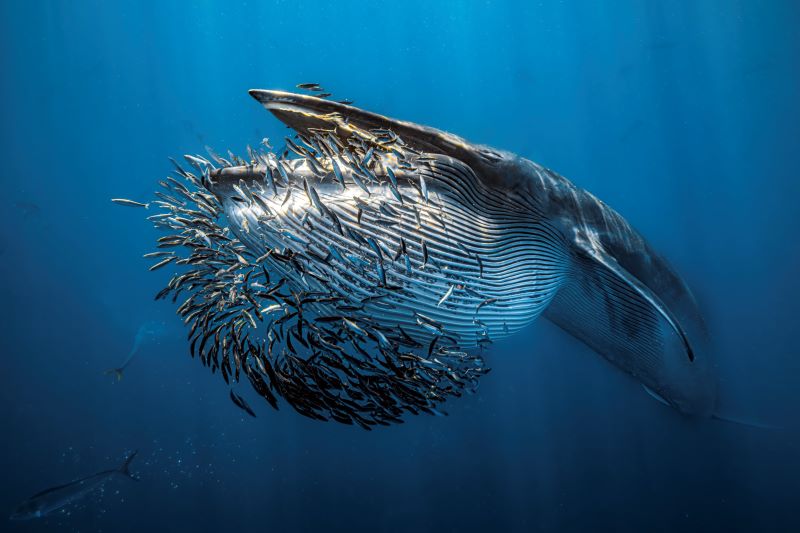
Photo: Rafael
Fernandez Caballero
Lisa Stengel from the United States was named Up & Coming Underwater Photographer of the Year 2024 for her image of a mahi-mahi catching a sardine, in Mexico. Stengel used both a very fast shutter speed and her hearing to catch the moment. “If you listen there’s an enormous amount of sound in the ocean,” she explained. “The action was too fast to see, so I honed in on the sound of the attacks with my camera to capture this special moment.”
“It is such an exciting time in underwater photography because photographers are capturing such amazing new images, by visiting new locations and using the latest cameras,”
commented judge Alex Mustard. “Until this year I’d hardly ever see a photo of a mahi mahi,
now Lisa has photographed one hunting, action that plays out in the blink of an eye.”
The Underwater Photographer of the Year contest is based in the UK, and Jenny Stock,
was named as British Underwater Photographer of the Year 2024 for her image “Star
Attraction”, which finds beauty in species of British wildlife that are often overlooked.
Exploring the west coast of Scotland, Stock explained “in the dark green depths my torch
picked out the vivid colours of a living carpet of thousands of brittle stars, each with a
different pattern. I was happily snapping away, when I spotted this purple sea urchin and I
got really excited.”
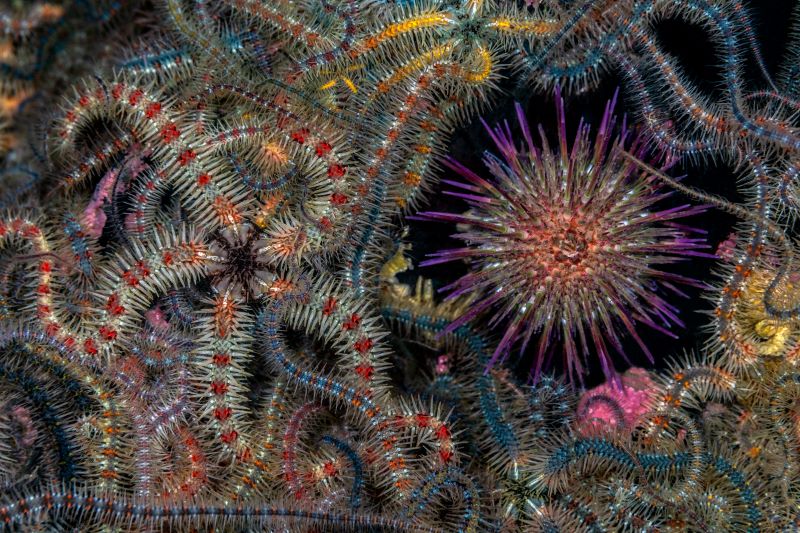
Photo: Jenny Stock
In the same contest, Portuguese photographer, Nuno Sá, was named ‘Save Our Seas
Foundation’ Marine Conservation Photographer of the Year 2024, with his photo ‘Saving
Goliath’, taken in Portugal. Sá’s photo shows beachgoers trying to save a stranded sperm
whale. The picture gives us hope that people do care and want to help the oceans, but also
warns us that bigger changes are needed. “The whale had been struck by a ship and its fate
was sealed,” explains Sá. “An estimated 20,000 whales are killed every year, and many more
injured, after being struck by ships-and few people even realise that it happens.”
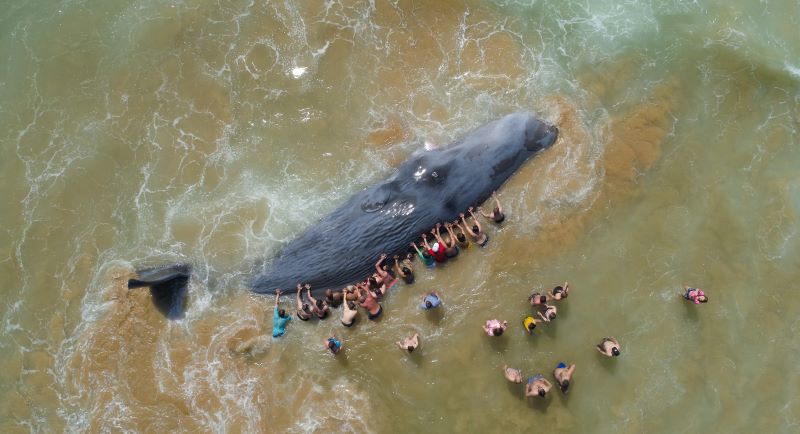
Photo: Nuno Sá
More winning images can be found at www.underwaterphotographeroftheyear.com.
About Underwater Photographer of the Year
Underwater Photographer of the Year is an annual competition, based in the UK, that celebrates photography beneath the surface of the ocean, lakes, rivers and even swimming pools, and attracts entries from all around the world. The contest has 13 categories, testing photographers with themes such as Macro, Wide Angle, Behaviour and Wreck photography, as well as four categories for photos taken specifically in British waters. The winners were announced in an award ceremony in Mayfair, London, hosted by The Crown Estate. This year’s UPY judges were experienced underwater photographers Peter Rowlands, Tobias Friedrich and Dr Alexander Mustard MBE.
Header image: Underwater Photographer of the Year 2024 winner Alex Dawson
News
World’s Best Underwater Photographers Unveil Breathtaking Images at World Shootout 2023
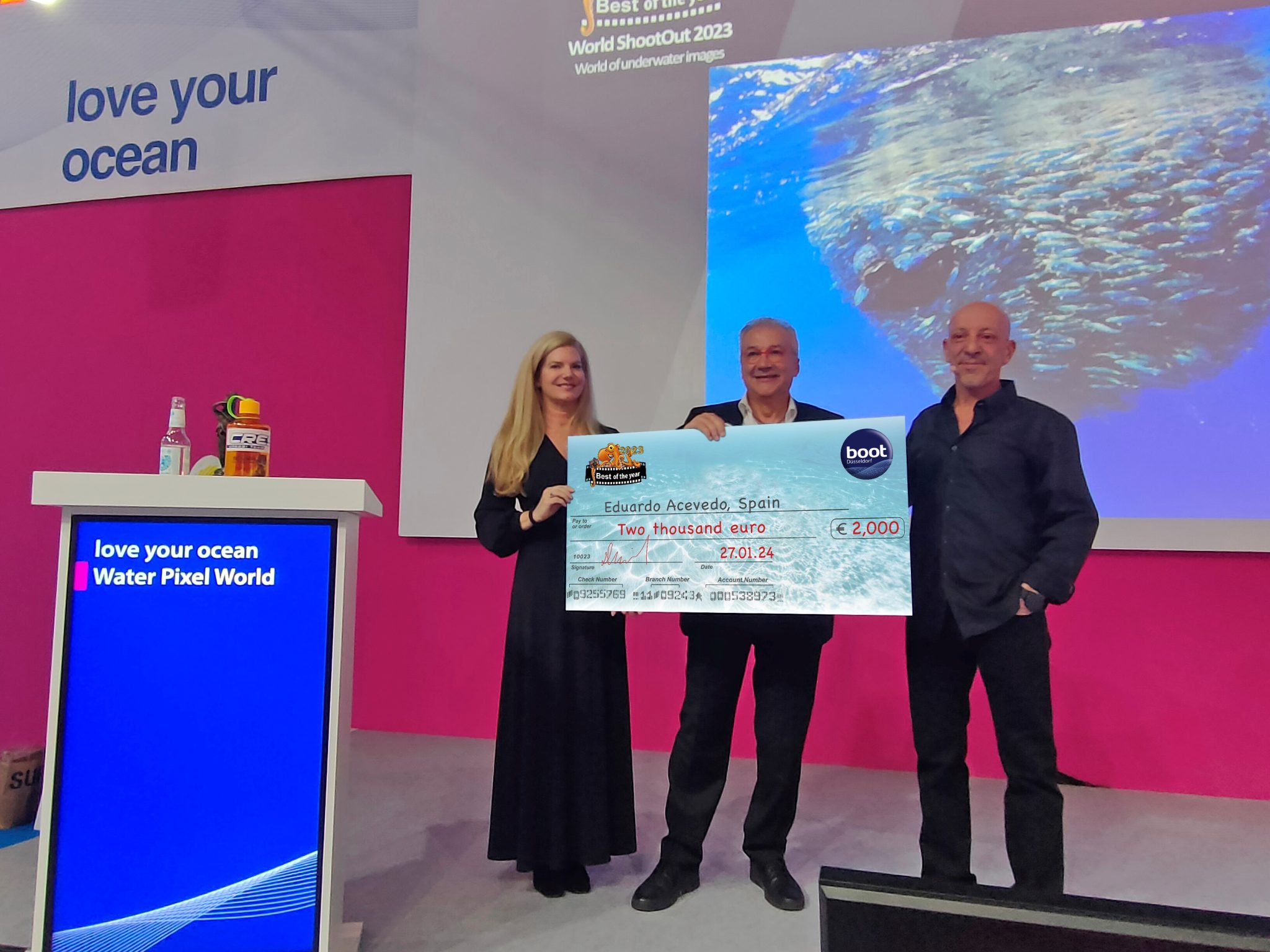
The winners of the prestigious World Shootout 2023 underwater photography competition were announced at this year’s BOOT Show, captivating audiences at the world’s largest diving and water sports exhibition in Dusseldorf, Germany. Hundreds of photographers from 54 countries competed across nine categories, pushing the boundaries of creativity and technical skill.
Grand Prize Winners
- Picture of the Year: Spanish photographer Eduardo Acevedo “secured” the top Honor with the prestigious prize the “boot Dusseldorf Director’s Prize, earning an Andromeda statuette and a €2,000 cash prize.
- Best 5 Images Portfolio: Luc Rooman from Belgium triumphed in this category, winning a dream 4-week diving trip for two to Papua New Guinea, valued at $18,900.
- Amateur Photographer: Alexandra Ceurvorst from the USA impressed the judges with her talent, taking home the 1,000 € cash prize award.
Celebrating Diversity and Innovation
This year’s competition saw 11,680 entries from 964 photographers, showcasing a remarkable spectrum of skills and perspectives. From the intricate wonders of Macro photography to the beauty of “Black Water”, the “Underwater Fashion” category added a touch of artistry and innovation, while the ever-important ” Environmental & Conservation” category served as a powerful reminder of the need to protect these fragile ecosystems.
Looking Ahead: AI and Ocean Conservation
World Shootout founder and producer David Pilosof unveiled an exciting addition for the 2024 competition: this year the Environmental category will be focusing on the impact of plastic on our oceans and future.
This category will embrace the potential of AI or other editing software as a tool to amplify the conservation message.
Entrants will submit campaigns of three original underwater photographs dealing with plastic pollution, along with their final AI assistance processing. This innovative approach encourages artistic expression while raising awareness about a critical environmental issue.
Explore the Stunning Collection
Discover the complete album of competition entries by clicking here.
For Low-resolution photos of finalist entries in eight categories, click here.
-

 News3 months ago
News3 months agoHone your underwater photography skills with Alphamarine Photography at Red Sea Diving Safari in March
-

 News3 months ago
News3 months agoCapturing Critters in Lembeh Underwater Photography Workshop 2024: Event Roundup
-

 Marine Life & Conservation Blogs3 months ago
Marine Life & Conservation Blogs3 months agoCreature Feature: Swell Sharks
-

 Blogs2 months ago
Blogs2 months agoMurex Resorts: Passport to Paradise!
-

 Blogs2 months ago
Blogs2 months agoDiver Discovering Whale Skeletons Beneath Ice Judged World’s Best Underwater Photograph
-

 Gear Reviews2 weeks ago
Gear Reviews2 weeks agoGEAR REVIEW – Revolutionising Diving Comfort: The Sharkskin T2 Chillproof Suit
-

 Marine Life & Conservation2 months ago
Marine Life & Conservation2 months agoSave the Manatee Club launches brand new webcams at Silver Springs State Park, Florida
-

 Gear Reviews3 months ago
Gear Reviews3 months agoGear Review: Oceanic+ Dive Housing for iPhone


